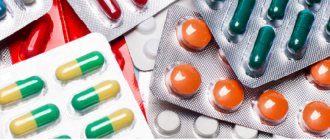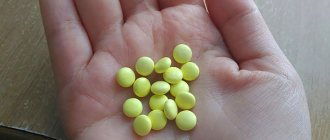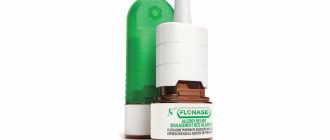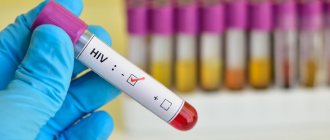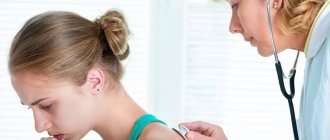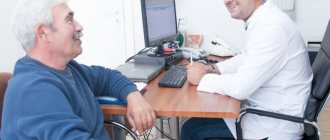Broad-spectrum antibiotics: TOP 20 best
The list of broad-spectrum antibiotics includes drugs from different groups. Drugs from a number of fluoroquinolones, nitroimidazoles, glycopeptides and from the phosphoric acid group have particularly high activity.
Below you can familiarize yourself with the characteristics of the best broad-spectrum antibiotics and methods of their use. Antibiotics are prescribed by the attending physician taking into account the sensitivity of the pathogen based on laboratory data. In some cases, urgent prescription of antibacterial agents is necessary, then the choice falls on broad-spectrum antibiotics.
With long-term treatment, bacterial resistance to antibiotics may develop; in this situation, it is necessary to change drugs to others or use a complex of several drugs. The duration of antibiotic therapy is determined by the severity of the disease, the presence of complications and concomitant pathologies. Doses of modern broad-spectrum antibiotics are selected by the attending physician individually, taking into account the patient’s age and possible contraindications.
How do new generation antibiotics work?
Unlike drugs from the antiseptic group, the antibiotic has a proper therapeutic effect not only after external application, but also acts systemically after oral, intravenous, and intramuscular use.
New generation antibiotics are capable of:
- Affect the synthesis of cell walls by disrupting the production of vital peptide complexes.
- Impair the functioning and integrity of the cell membrane.
- Disturb the synthesis of protein necessary for the growth and functioning of the pathogenic pathogen.
- Suppress nucleic acid synthesis.
Based on the nature of their effect on bacterial cells, antibiotics are divided into:
- Bactericidal - the pathogen will die and will then be eliminated from the body.
- Bacteriostatic - the active component does not kill bacteria, but disrupts their ability to reproduce.
It is important to determine how active the active substance of the drug is in relation to a particular pathogen of the pathological process. To do this, you need to undergo a series of laboratory tests prescribed by your doctor.
Medicine before the invention of penicillin
In the Middle Ages, humanity knew about the enormous benefits of moldy bread and a certain type of mushroom. Such medicinal components were actively used to disinfect purulent wounds of combatants and prevent blood poisoning after surgery. There was still a lot of time before the scientific discovery of antibiotics, so doctors drew the positive aspects of penicillins from the surrounding nature and determined them through numerous experiments. They tested the effectiveness of new drugs on wounded soldiers and women in a state of childbed fever.
How were infectious diseases treated?
Not knowing the world of antibiotics, people lived according to the principle: “Only the strongest survive,” according to the principle of natural selection. Women died from sepsis during childbirth, and soldiers died from blood poisoning and suppuration of open wounds. At that time, they could not find a means to effectively cleanse wounds and prevent infection, so healers and healers more often used local antiseptics. Later, in 1867, a surgeon from Great Britain identified the infectious causes of suppuration and the benefits of carbolic acid. At that time, this was the main treatment for purulent wounds, without the use of antibiotics.
Rules for prescribing antibiotics
In order for antibiotics to be as effective as possible and not give serious side effects, when selecting and prescribing them, it is necessary to take into account the form of the disease and its severity, as well as determine the cause of the pathology (ideally, using culture results, find out which microbe caused the inflammation).
In addition, it is important to determine the sensitivity of bacteria to certain antibiotics that are planned to be used. Naturally, this is difficult to do in pediatric practice, and there are conditions in which a delay of several days, which is spent on performing cultures and determining sensitivity to antibiotics, can become fatal.
These include acute otitis media, tonsillitis or pneumonia, pyelonephritis and some other conditions. In these cases, antimicrobial therapy is prescribed immediately, based on clinical recommendations and treatment protocols that have been developed over years of treatment. If necessary, therapy is adjusted based on culture results already during treatment, if it is ineffective.
The world before antibiotics
From a school course on the history of ancient times, we all once learned about the terribly short life expectancy of people. Men and women who miraculously reached thirty years of age were considered long-livers, but it would be difficult to call them healthy: by this age, the skin was covered with numerous defects, teeth rotted and fell out, and internal organs worked to the point of wear and tear due to a meager diet and hard physical labor.
Infant mortality was at an alarming rate, and the death of women from “puerperal fever” was common. It is enough to look at the biography of famous people of the 16th – 19th centuries to see confirmation of this sad fact: for example, in the family of the great writer and playwright Nikolai Vasilyevich Gogol there were 12 children, including himself: 6 girls and 6 boys. Of these, only 4 sisters survived to adulthood, and the rest of Gogol’s brothers and sisters died either immediately after birth or in childhood from illnesses. And no wonder, because by the time the writer passed away, the inventor of antibiotics had not even been born.
However, at all times, people have tried to find a cure for infectious diseases, without even realizing their infectious nature and the danger of contact with carriers. And what could act as a source of medicine, if not the gifts of nature? From herbs, fruits, seeds, roots and mushrooms, ancient healers tried experimentally to obtain healing potions for a variety of diseases - often without success, but sometimes luck smiled on them. The most effective recipes were passed down from generation to generation, and this is how traditional medicine developed. And everything new is, as we know, a well-forgotten old. Therefore, the true inventor of antibiotics probably lived and healed people many centuries before countless boxes of pills appeared on modern pharmacy counters.
Ancient history and the Middle Ages
It is known that about two and a half thousand years ago, Chinese monasteries used a gruel made from fermented soybean flour to treat purulent wounds and cuts in warriors injured in sword fighting. The meaning of the technique is obvious: the yeast-like microorganisms contained in this improvised “antiseptic” prevented the proliferation of pyogenic bacteria, and thereby prevented blood poisoning.
Representatives of another wisest ancient civilization and the builders of the pyramids, the Egyptians, also had the inventor of antibiotics in their ranks. True, he did not do this for a good purpose - one of the court doctors came up with the idea of tying bandages with moldy bread around the ankles of slaves damaged by shackles. This made it possible to prolong the life of the unfortunate people and force them to work in the quarries longer.
In medieval Europe, a similar method of treating purulent wounds arose: they were treated with cheese whey. The principle of action is the same - yeast against bacteria. Of course, doctors back then did not know either of these two concepts, but this did not stop them from applying bandages soaked in serum to the festering wounds received by warriors on the fields of numerous battles between the kingdoms. The person who first came up with this treatment method can also rightfully be called the inventor of antibiotics.
New and Contemporary times
Just think - only at the beginning of the nineteenth century, when humanity was already storming the oceans and constructing aircraft, people first realized the contagiousness of infections and introduced the term “bacteria” (in 1828 by Christian Ehrenberg). Before this, no doctor had been able to trace a direct connection between contamination of wounds, their suppuration and the death of patients. In the infirmaries, people were given bandages from any available material and did not change them, not seeing any need for it.
And in 1867, the British surgeon D. Lister put an end to this and even found a remedy to combat purulent infections and postoperative complications. He proposed using carbolic acid to disinfect wound surfaces, and for a long time this substance was the only hope of salvation for “severe” surgical patients. Lister is, if not the inventor of antibiotics, then certainly the discoverer of sanitation and antiseptics.
Diseases and spectrum of action of antibiotics
Back in the late 19th century, bacteriologist Hans Gram discovered that different bacteria react differently to staining. Some acquire a pronounced color, while others, on the contrary, quickly discolor. This simple experience was of great importance from a practical point of view. After all, different reactions to the dye spoke about the properties of the bacterial cell wall. This means that it suggested exactly how antibiotics should act on the microorganism.
Since then, there has been a basic division into gram-negative (non-staining) and gram-positive (staining) bacteria.
- Gram (+) is the causative agent of most infections of the respiratory tract, nasopharynx, ear, and eye. These include, in particular, staphylococci and streptococci.
- Gram (-) - Bacteria in this group can cause serious illness. These are Escherichia coli, Koch bacillus, salmonella, shigella (the causative agent of diphtheria), gonococcus, meningococcus.
The spectrum of action of antibiotics is determined by which bacteria are sensitive to a particular drug. And if narrow-spectrum antibiotics more often act on either Gram (+) or Gram (-), then a wide spectrum allows them to affect both.
The first antibiotics and antiseptics
By the end of the nineteenth century, the problem of insufficient effectiveness of antiseptics became obvious. The solutions available to doctors at that time were unsuitable for treating infections of internal organs, and when treating wounds they did not penetrate deep enough into the infected tissues. In addition, the effect of antiseptics was weakened by the patient’s biological fluids and was accompanied by numerous side effects.
The time has come for global changes, and scientists throughout the civilized world have begun active research in the field of infectious medicine. There were 50 years left before the official discovery of the first antibiotic...
In what century were antibiotics invented?
The very phenomenon of antibiosis, that is, the ability of some living microorganisms to destroy others or deprive them of the opportunity to reproduce, was discovered in the 80s of the nineteenth century. The famous French biochemist and microbiologist Louis Pasteur, the author of the method of pasteurization of food products, in one of his scientific works published in 1887, described the antagonism of soil bacteria and Koch bacilli - the causative agents of tuberculosis.
The next important step in the right direction was the study by the famous Russian scientist Ivan Mechnikov of the effect of acidophilus bacteria contained in fermented milk products on the human digestive tract. Mechnikov argued that fermented baked milk, kefir, yogurt and other similar drinks have a beneficial effect on health and can even fight intestinal disorders. This was later confirmed by the outstanding Russian pediatrician of German-French origin, Eduard Hartier, who tried to treat digestive disorders in children with fermented milk products and described the positive results of therapy.
Military field doctor Ernest Duchesne from the French city of Lyon came even closer to the solution. He saw that Arabian grooms used the mold to treat back injuries suffered by horses from the saddle during long journeys. Moreover, the mold was collected directly from this very saddle. Duchesne took a sample of it, named it Penicillium glaucum, used it against typhoid fever in guinea pigs, and also confirmed the destructive effect of mold on the bacteria Escherichia coli (Escherichia coli).
A young doctor (he was only 23 years old) wrote a dissertation based on his research and sent the document to the Pasteur Institute in Paris, but they did not pay attention to the most important scientific work and did not even notify the author of receipt and reading - apparently, they did not take Ernest Duchenne seriously from - for his young age and little experience. But it was this Frenchman who came closest to the fateful discovery and could rightfully bear the title “inventor of antibiotics.” But fame came to him after his death, in 1949, 4 years after other people were awarded the Nobel Prize for this.
Chronology of the invention of antibiotics:
- 1896 - Mycophenolic acid, which destroys anthrax, is isolated from the mold Penicillium brevicompactum. The author of the study is B. Gozio;
- 1899 - a local antiseptic based on pyocenase, a substance obtained from the bacteria Pseudomonas pyocyanea, was invented. Authors: R. Emmerich and O. Lowe;
- 1928 - A. Fleming discovered the antibiotic penicillin, but was unable to develop a stable drug suitable for mass production;
- 1935 - D. Gerhard published an article on the antibacterial effect of prontosil in the German scientific journal Deutsche Medizinische Wochenschrift, and in 1939 received the Nobel Prize in Physiology or Medicine for this research;
- 1937 - M. Welsh discovered actinomycin, the first antibiotic of the streptomycin series;
- 1939 - N.A. Krasilnikov and A.I. Korenyako invented the antibiotic mycetin, R. Dubos discovered tyrothricin, and the production of streptocide began at the pharmaceutical plant;
- 1940 - E.B. Chain and G. Flory managed to isolate penicillin in crystalline form and created a stable extract;
- 1942 - Z. Vaksman first introduced the term “antibiotic” into medical use.
So, the era of penicillin began only in 1940, when the American followers of the works of A. Fleming managed to obtain a stable chemical compound with an antibacterial effect from mold. But first things first.
Broad-spectrum antibiotics: list of drugs
Broad-spectrum antibiotics are universal bactericidal drugs that will help get rid of many diseases. Most often they are prescribed for the treatment of various infections, the causative agent of which remains unknown. They are also prescribed if a person has become infected with a fast-growing and dangerous virus.
The list of modern antibiotics is presented in the table below:
| Group | A drug | Mechanism of action |
| Tetracyclines | Doxycycline, Tetracycline | Kills bacteria and has an antiviral effect |
| Levomycetin | Moxifloxacin, Levofloxacin | Antimicrobial, antifungal and antibactericidal |
| Semi-synthetic penicillins | Carbenicillin, Ticarcillin | Inhibits the synthesis of the pathogen cell wall |
| Cephalosporins | Ceftriaxone | Changes the activity of a virus that has entered the RNA |
| Rifampicins | Streptomycin, Amphenicol | Interferes with protein production |
| Carbapenems | Meropenem, Meropenem, Cyronem, Imipenem | Antibacterial and anti-inflammatory, prolonged action |
Also, such drugs may be indicated as prophylaxis after major surgical interventions. Remember that not all cheap drugs are so bad.
Classification of antibiotics
There are many different classifications of antibiotics. The most common classification is based on their chemical structure.
Practitioners can alternate antibiotics with different chemical structures in the same patient to prevent pathogenic bacteria from developing resistance to the antibiotic. This resistance, when the antibiotic no longer works, is called resistance.
- Penicillins (benzylpenicillin, ampicillin, amoxicillin)
- Cephalosporins (cefazolin, ceftriaxone, cefuroxime, cephalexin, ceftazidime, cefpirome, etc.)
- Macrolides and azalides (erythromycin, clarithromycin, roxithromycin, azithromycin, josamycin)
- Carbapenems and monobactams (imipenem, meropenem, aztreonam)
- Tetracyclines (tetracycline, doxycycline)
- Amnoglycosides (streptomycin, kanamycin, gentamicin, amikacin, netilmecin)
- Chloramphenicols (chloramphenicol, syntomycin)
- Lincosamides (lincomycin)
- Glycopeptides (vancomycin, teicoplanin)
- Other antibiotics (rifampicin, polymyxin, fusidine, gramicidin)
Synthetic antibacterial agents
- Fluoroquinolones (ciprofloxacin, norfloxacin, ofloxacin, etc.)
- Sulfonamides (streptocide, sodium sulfacyl, sulfamethoxazole, etc.)
- Nitrofurans (nifuratel, nifuroxazide, furacillin, etc.)
- Hydroxyquinolines (nitroxoline)
Cephalosporins
Active against staphylococcal infections, as well as Proteus, Klebsiella, E. coli, pathogens of sore throat and pneumonia, urinary tract diseases, osteomyelitis, meningitis.
Antibiotics in this group include:
Parenteral 3rd generation:
| Representatives | Trade name and method of application |
| Cefotaxime | Klaforan : powder for injection solution: 0.5-2.0 g. x 1 time per day intramuscularly or intravenously slowly. Cefosin : powder for injection solution: 1.0 g each. every 8-12 hours intramuscularly, intravenously slowly/drip. |
| Cefoperazone | Cephobid : powder for injection solution: 2.0-4.0 g. per day for 2 intramuscular injections. Cefpar : powder for injection solution: 2.0-4.0 g each. every 12 hours intravenously/intramuscularly. |
| Ceftriaxone | Ceftriaxone : powder for injection solution: 1.0-2.0 g. x 1 time per day intramuscularly/intravenously. Azaran : powder for injection solution: 1.0 g. dissolve in 3.5 ml of 1% solution of lidocaine hydrochloride, intramuscular injections 1 time per day. |
| Ceftazidime | Fortum : powder for injection solution: 1.0-6.0 g each. x 1 time per day for 2-3 intravenous/intramuscular infusions. Ceftidine : powder for injection solution: 1.0-6.0 g. x 1 time per day intravenously/intramuscularly. |
Parenteral 3rd generation:
| Representatives | Trade name and method of application |
| Cefditoren | Spectracef : tablets: 0.2-0.4 g. x 2 times a day. |
| Ceftibuten | Tsedex : capsules: 0.4 g each. once a day. |
| Cefixime | Suprax Solutab: effervescent tablets: 0.4 g each. x 1 time per day or 0.2 g. x 2 times a day, dissolve in advance in a glass of water. Suprax: capsules: 0.4 g each. x 1 time per day. Pancef : tablets: 0.4 g each. once a day or 0.2 g. twice a day. |
5th generation (parenteral):
| Representatives | Trade name and method of application |
| Ceftaroline | Zinforo : powder for injection solution: 0.6 g. every 12 hours intravenously for an hour. |
| Ceftobiprole | Zeftera : lyophilisate for injection solution: not used in the Russian Federation. |
Which brand of antibiotics is better to choose?
Often the same drug is produced by different pharmaceutical companies, so their composition and dosage may differ slightly. Doctors can advise the patient which manufacturer’s medication to buy so that the treatment is more effective. The best antibiotics are produced by the following companies:
- Astellas Pharma Europe is the Dutch representative office of a Japanese public company, which was founded through the merger of 2 pharmaceutical companies. In the 1970s they opened offices in Europe and the USA. In 2005, they merged and the headquarters were located in Tokyo. The company's mission is to improve people's health through the production of innovative and reliable medicines.
- KRKA is an international pharmaceutical company headquartered in Slovenia. Founded in 1954 as a small laboratory. Produces generic drugs. Their active ingredient is the same as the original, but the composition contains other auxiliary components. The company's factories are located in Germany, Poland, Russia, Croatia, and Slovenia.
- Dalkhimpharm is the legal successor of the Khabarovsk Chemical Plant, which was founded in 1939. It is considered one of the oldest drug production enterprises in Russia and is one of the country's top ten pharmaceutical manufacturers. The main principle of work is to provide clients with effective, high-quality and safe drugs. All products are tested by the Moscow quality control center.
- Sandoz is a pharmaceutical company founded in Germany by Eduard Sandoz and Alfred Kern in 1886. It produces generics that are used in the treatment of various diseases. Products are represented in the markets of more than 140 countries. Now it is one of the top three producers of amoxicillin.
- Laboratoires Bouchara -Recordati – founded in Italy in 1926. In 1999 and 2000, he acquired pharmaceutical companies in France, at whose factories he began production of the antibiotic framycetin under the trade name Isofra. The company's products are represented in the markets of Europe, the USA, Canada, South America, and North Africa. The company's goal is to improve the quality of life of people.
- JSC FP "Obolenskoe" is a Russian company, created on the basis of the State Scientific Center for Applied Microbiology in 1994. Since 2013, it has been part of the Alvansa group of companies. The quality of products, according to the results of external audits, meets international standards. The company produces more than 150 drugs of various pharmacotherapeutic groups. Among them there are generics and innovative developments.
- Pliva is the largest pharmaceutical company in Southern Europe with its head office in Zagreb, Croatia. Founded in 1921, since 2008 acquired by TEVA and operates as its department. The main activity is aimed at the development and production of generics. The most popular antibiotic of this company is Sumamed.
- GlaxoSmithKline is a British pharmaceutical company founded in 2000 through the merger of two companies. Representative offices are opened in Germany, Italy, Australia, Canada, Poland and other countries. The main factories are located in Singapore, USA, UK, Spain. Products are represented on the markets of 160 countries. A popular drug from this company is considered a strong broad-spectrum antibiotic Augmentin.
- PJSC Biosintez is a group of companies that includes the largest Russian pharmaceutical enterprises. Founded in Penza in 1955. The first antibiotic was released in 1959. It ranks 5th in the world in the production of generic drugs. The quality of medicines is recognized in 150 countries.
- Olain Farm is the largest pharmaceutical company in the Baltic countries, founded in 1972. The headquarters is located in Latvia. The quality of the products is confirmed by audits of well-known companies in Switzerland, the USA, and France. In the territory of the former USSR, the company became the first whose drug was included in the WHO list.
- Synthesis is a Russian plant, created on the basis of the Kurgan Medicinal Products Plant for the production of antibiotics. Also produces vitamin B12 and endocrine drugs. Since 1987, engineers have introduced new technology for producing ampicillin trihydrate.
Macrolides
Macrolides tend to accumulate in tissues, and not in blood serum, like other groups. They are used in the treatment of bronchitis and community-acquired pneumonia as a monomedicine (in case of intolerance to penicillins), pathologies of the ENT organs (pharyngitis, sinusitis, otitis, laryngitis and others) and sexually transmitted diseases (syphilis, gonorrhea, benorrhea).
Antibiotics in this group include:
14-member:
| Representatives | Trade name and method of application |
| Erythromycin | Erythromycin:
|
| Oleandomycin | Oleandomycin phosphate : powder substance. Practically not used at present. |
| Roxithromycin | RoxyHEXAL: tablets: 0.15 g each. twice a day or 0.3 g. at one time, the course is taken for 10 days. Esparoxy: tablets: 0.15 g each. twice a day 15 minutes before meals or 0.3 g. once, the course of administration is 10 days. Rulid : tablets: 0.15 g each. twice a day, course of treatment is 10 days. |
| Clarithromycin | Klacid: tablets: 0.5 g. twice a day, taken for 2 weeks. Fromilid: tablets: 0.5 g twice a day, taken for 2 weeks. Clarithrosin : tablets: 0.25 g. twice a day, taken for 2 weeks. |
15-member:
| Representatives | Trade name and method of application |
| Azithromycin | Sumamed: capsules: 0.5 g each. x 1 time per day before or 2 hours after meals. Azitrox: capsules: 0.25-0.5 g each. x 1 time per day. Azitral : capsules: 0.25-0.5 g. x 1 time per day before or after meals. |
16-member:
| Representatives | Trade name and method of application |
| Spiramycin | Spiramycin-vero : tablets: 2-3 tablets (3 million IU) in 2-3 doses per day. Rovamycin : tablets: 2-3 tablets (3 million IU) or 5-6 tablets (6-9 million IU) for 2-3 doses per day. |
| Josamycin | Vilprafen : tablets: 0.5 g. twice a day, without chewing, with water. Vilprafen solutab : tablets: 0.5 g each. x twice a day, without chewing or dissolved in 20 ml of water. |
| Midecamycin | Macropen : tablets: 0.4 g each. three times a day, course of administration for 2 weeks. |
Aminoglycosides
The first generation is used in the treatment of plague and tuberculosis only in combination with tetracycline. Third and fourth for tuberculosis, sepsis, severe hospital infections such as pneumonia.
Antibiotics in this group include:
1st generation:
| Representatives | Trade name and method of application |
| Neomycin | Neomycin : external aerosol: on the affected areas of the skin, shake well and place the balloon at a distance of 15-20 cm, apply for 3 seconds; Repeat application 1-3 times a day. |
| Streptomycin | Streptomycin : powder for injection solution: 0.5–1.0 g. x 2 times a day intramuscularly. To prepare the solution, use sterile water/saline solution/0.25% novocaine. Calculation: per 1.0 g. medications - 4 ml of solvent. Streptomycin sulfate . Substance-powder: for intramuscular administration - 0.5-1.0 g. per day. For intratracheal/aerosol administration – 0.5-1.0 g. x 2-3 times every 7 days. |
| Kanamycin | Kanamycin : powder for injection solution: 1.0-1.5 g. for 2-3 injections intravenously (a single dose (0.5 g) is dissolved in 200 ml of a 5% dextrose solution). Kanamycin sulfate : for intramuscular administration 0.5 g./1.0 g. dissolve in 2/4 ml of sterile water or 0.25% novocaine. For intravenous administration 0.5 g. dissolve in 200 ml of saline or 5% glucose solution. |
2nd generation:
| Representatives | Trade name and method of application |
| Tobramycin | Tobrex: eye drops: 1-2 drops, pulling back the lower eyelid, every 4 hours; for severe eye infections - 2 drops every hour. Tobriss: eye drops: 1 drop, pulling back the lower eyelid, 2 times a day (morning and evening); for severe eye infections - 1 drop x 4 times a day. Bramitob : solution for inhalation: 1 ampoule of medication (0.3 g) every 12 hours, administered by inhalation using a nebulizer, course 28 days. |
| Gentamicin | Gentamicin : solution for injection: 0.003-0.005 g. per 1 kg of weight for 2-4 injections, administered intravenously/intramuscularly. Eye drops: 1-2 drops every 1-4 hours, retracting the lower eyelid. Ointment: 3-4 applications per day to affected areas of the skin. Gentamicin sulfate : powder up to 1.2 mg per 1 kg of body weight per day for 2-3 injections (urinary infections); 2.4-3.3 mg per 1 kg of body weight per day for 2-3 injections (severe infections, sepsis). Administer the medicine intramuscularly/intravenously. |
3rd generation:
| Representatives | Trade name and method of application |
| Framycetin | Isofra : nasal spray: 1 injection into each nasal passage x 4-6 times a day, course no more than 10 days. |
| Spectinomycin | Kirin : powder for making a suspension: 2.0 g each. (5 ml)/4.0 g. (10 ml) deep intramuscularly into the upper outer part of the buttock. To prepare the suspension, you need to add 3.2 ml of sterile water to the vial. Suspension for single use, storage is prohibited. |
| Amikacin | Amikacin: solution for infusion: 0.01-0.015 g. per 1 kg of body weight per day for 2-3 injections, administered intramuscularly/intravenously (stream, drip). Amikacin sulfate: substance-powder: 0.005 g each. per 1 kg of weight every 8 hours or 0.0075 g. per 1 kg of body weight every 12 hours, administered intramuscularly/intravenously. |
| Netilmicin | Nettacin : eye drops: 1-2 drops, pulling back the lower eyelid, 3 times a day. Vero-Netilmicin : solution for injection: 4-6 mg per 1 kg of body weight per day intravenously/intramuscularly; for severe infections, the daily dose can be increased to 7.5 mg per 1 kg. |
Carbapenems
As a rule, we encounter carbapenems extremely rarely or not at all. And this is wonderful - after all, these antibiotics are indicated for the treatment of severe hospital infections that threaten life. The spectrum of action of carabapenems includes most existing pathological strains, including resistant ones.
Antibiotics in this group include:
| Representatives | Trade name and method of application |
| Doripenem | Doriprex : powder for injection solution: 0.5 g each. intravenously every 8 hours. To prepare the solution, the powder must be dissolved in 10 ml of isotonic sodium chloride solution, the resulting mixture should be added to a bag with 100 ml of isotonic sodium chloride solution or 5% glucose solution. |
| Ertapenem | Invanz : lyophilisate for injection solution: 1.0 g each. per day, administered in 1 injection intravenously/intramuscularly. |
| Meropenem | Meronem: powder for injection solution:
The medicine is administered intravenously slowly (within 5 minutes; the solution is prepared by adding 5 ml of sterile water per 250 mg of the drug) or intravenously drip (within 15-30 minutes; the solution is prepared by adding 50-200 ml of isotonic sodium chloride). Meropenem : powder for injection solution:
|
| Imipenem + cilastatin | Tsilaspen: powder for injection solution: the method of preparing the solution and using it is similar to the above. Tiepenem: powder for injection solution: 1.0-2.0 g. per day, administered intravenously in 3-4 infusions. To prepare the solution, you need to add isotonic sodium chloride to the bottle in a ratio of 100 ml of sodium chloride per 0.5 g. drug, shake until completely homogeneous. Tsilapenem : powder for injection solution: 1.0-2.0 g. per day, administered intravenously in 3-4 infusions. To prepare the solution, add 100 ml of isotonic sodium chloride to the bottle and shake until smooth. Tienam : powder for injection solution: 2.0 g each. per day, administered in 4 injections intravenously/intramuscularly. |
The dispute in which a scientific discovery was born
The history of the invention of an antibiotic from mold fungi began in the 60s of the nineteenth century in Russia. Two scientists, Alexey Polotebnov and Vyacheslav Manassein, argued about the nature of the most ancient nuisance - mold, which is very difficult to fight. Polotebnov believed that mold acts as a kind of progenitor of all microbes living on Earth. Manassein categorically disagreed with this point of view - he believed that mold has a unique biological structure and is fundamentally different from other microorganisms.
To support his opinion with facts, Manassein began to study green mold and soon discovered that there were no colonies of bacteria in the immediate vicinity of its strains. From this, the scientist concluded that mold prevents microbes from multiplying and feeding. He shared the results of his observations with Polotebnov, who admitted he was wrong and set about inventing an antiseptic emulsion based on mold. With the resulting remedy, Manassein's former opponent was able to successfully treat skin infections and non-healing wounds.
The result of the joint research work of the two scientists was a scientific article entitled “The Pathological Significance of Mold,” which was published in 1872. But, unfortunately, the international medical community of that time did not pay due attention to the work of Russian specialists. And they, in turn, did not transfer their research to the development of a drug for internal use, and limited themselves to a local antiseptic. If not for these circumstances, who knows - perhaps a Russian scientist would have become the inventor of antibiotics.
Penicillins
With the discovery of an antibiotic of this particular group - Benzylpenicillin - doctors realized that microbes could be defeated. Despite its venerable age, benzylpenicillin is still used today, and in some cases it is a first-line drug. However, broad-spectrum agents include other, newer penicillin antibiotics, which can be divided into several groups.
| Representatives | Trade name and method of application |
| Ampicillin | Ampicillin:
|
| Amoxicillin + clavulanic acid | Amoxiclav: tablets: 1 tablet (250+125 mg) three times a day or 1 tablet (500+125 mg) twice a day; take with food, course of treatment for 2 weeks. Powder for suspension: use the attached tables to calculate the dose of the medicine. Augmentin: tablets: 1 tablet (250+125 mg) three times a day, course of administration for 2 weeks. Powder for suspension: add 60 ml of clean water at room temperature to the bottle with the powder, wait 5 minutes, add the volume of water to the mark on the bottle, mix. Flemoclav Solutab : tablets: 1 tablet (500+125 mg) three times a day or 1 tablet (875+125 mg) twice a day; do not chew, take at the beginning of meals, take the course for 2 weeks. |
| Amoxicillin | Flemoxin Solutab: tablets: 0.5 g. twice a day, course of administration for 2 weeks. Amoxicillin: tablets: 0.5 g. twice a day, course of administration for 2 weeks. Amosin : capsules: similar regimen and duration of administration. Powder for suspension: pour the powder from the bag into a glass with warm, clean water, stir. |
Inventor of penicillin Alexander Fleming
This name is known to any of us from school, since it is written in “golden letters” in all biology textbooks. We should be grateful to this amazing person - talented, purposeful, persistent and, at the same time, very simple and modest. Alexander Fleming deserves recognition not only as the inventor of antibiotics, but also as a doctor who is completely devoted to science and understands the true purpose of his profession: mercy and selfless help to people.
The boy who changed the course of history was born on August 6, 1881 into a large Scottish family on the Lochwild farm. Until the age of twelve, Alexander studied at a school in Darvel, then for two years at the Kilmarnock Academy, and then moved to London closer to his older brothers, who lived and worked in the capital of Great Britain. There, the future inventor of antibiotics worked as a clerk and studied at the Royal Polytechnic Institute. He was inspired to turn his attention to medicine by the example of his brother, Thomas, who received a diploma as an ophthalmologist.
Alexander entered medical school at St. Mary's Hospital, and in 1901 managed to receive a scholarship there, leave his office job and concentrate entirely on his scientific development. Fleming began with surgery and pathological anatomy, but soon came to the conclusion that it would be much more interesting for him to study the nature of diseases and prevent their development than to observe the consequences on the operating table. Alec (that was his name in the family) had a great passion for laboratories, microscopes and reagents, so he retrained from a surgeon to a microbiologist.
Professor Almort Wright, who arrived at St. Mary's Hospital in 1902, had a huge influence on the development of Alexander Fleming as the inventor of antibiotics and the savior of millions of human lives. Wright at that time was already an eminent scientist - he developed a vaccine against typhoid fever. The professor carried out his research on the basis of the hospital and in 1906 created a group of young researchers, which included Alexander Fleming, who had just completed his course of study and received his doctorate.
Soon a big disaster came - the First World War. Alec served in Her Majesty's Royal Medical Army with the rank of captain and along the way studied the effects of shrapnel wounds from explosives. At the end of hostilities, the young specialist focused on finding a medicine that could prevent suppuration and alleviate the plight of the wounded soldiers. The inventor of antibiotics, Alexander Fleming, spent his entire life working in a research laboratory at St. Mary's Hospital, where he was elected professor and where he made his major discovery.
The scientist’s personal life was quite happy - on December 23, 1915, he married a young colleague Sarah (whom he affectionately called “Sarin”), and soon they had a son, Robert, who later also became a doctor. Saryn said about her husband: “Alec is a great man, it’s just that no one knows about it yet.” She died in 1949, and 4 years later, the widowed Fleming married another colleague of his, Greek by nationality, Amalia Kotsouri-Vourekas. But the couple’s happiness did not last long - on March 11, 1955, Sir Alexander Fleming, the inventor of antibiotics, died in his wife’s arms from a heart attack.
This is interesting: During his long and fruitful life (74 years), Fleming had a distinguished Masonic career, being awarded a knighthood, 26 medals, 18 international prizes (including a Nobel), 25 scientific degrees, 13 government awards and honorary membership in 89 academies of sciences. to the whole world.
On the grave of the famous scientist there is an inscription of gratitude from all mankind: “Here lies Alexander Fleming, the inventor of penicillin.” His personality is most clearly characterized by the fact that Fleming flatly refused to patent his invention. He believed that he had no right to profit from the sale of a drug on which people’s lives literally depended.
The scientist’s modesty is also evidenced by the fact that he was skeptical about his fame, calling it simply the “Fleming myth” and denied the feats attributed to him: for example, there were rumors that with the help of penicillin, Sir Alexander saved British Prime Minister Winston Churchill during World War II war. When Churchill fell ill in Carthage in 1943, he was cured by Lord Moran, who used sulfonamides, as Fleming pointed out in response to questions from journalists.
Fluoroquinolones
Probably, no doctor can imagine his medical practice without fluoroquinolone antibiotics. The first synthesized representatives of this group were distinguished by a narrow spectrum of action. With the development of pharmaceuticals, new generations of fluoroquinolone antibacterial agents were discovered and the spectrum of their activity expanded.
Antibiotics in this group include:
| Representatives | Trade name and method of application |
| Sparfloxacin | Sparflo : tablets: 0.1-0.4 g. per day (depending on the type and severity of the infection). |
| Gatifloxacin | Gatispan : tablets: 0.4 g. x 1 time per day, without chewing, course 10 days. |
| Moxifloxacin | Moflaxia : tablets: 0.4 g. x 1 time per day, without chewing, course 14 days. Avelox : tablets: 0.4 g. x 1 time per day, without chewing, course 14 days. |
| Levofloxacin | Tavanik: tablets: 0.25 gr. (2 tablets) twice a day or 0.5 g. (1 tablet) 1 time per day with water, course 14 days. Floracid : tablets: 0.5 g. twice a day, without chewing. |
Antibiotics for sore throat, bronchitis and cough
Inflammatory diseases of the upper respiratory tract are among the most common in clinical practice. Both children and adults are susceptible to diseases such as tonsillitis and bronchitis. Sometimes these pathological conditions can be caused by viruses, but often a bacterial infection is also associated. In this case, it is necessary to use antibacterial drugs (antibiotics). It should be recalled that antibiotic therapy should be carried out only after a complete examination of the patient, diagnosis and testing of the sensitivity of the flora to a particular antibiotic.
The following medications may be prescribed to treat these diseases:
| Name and group of the drug | Dosage |
| Flemoxin Solutab. Penicillin group, active ingredient – Amoxicillin. |
|
| Sumamed. A group of macrolides, the active ingredient is Azithromycin. |
|
| Gatispan. A group of fluoroquinolones, the active substance is Gatifloxacin. | 1 tablet 400 mg per day. |
| Avelox. A group of fluoroquinolones, the active substance is Moxifloxacin. | 1 tablet 400 mg per day. |
| Rulid. A group of macrolides, the active ingredient is Roxithromycin. | Adults and children weighing over 40 kg – 2 tablets of 150 mg 1-2 times a day. In other cases, the dosage is calculated individually. |
| AzitRus. A group of macrolides, the active ingredient is Azithromycin. | Adults and children over 12 years old – 1 capsule or tablet of 500 mg per day. Children over 3 years old – 10 mg per 1 kg of weight per day. |
The addition of a bacterial infection may be indicated by a sharp increase in body temperature, an increase in signs of general intoxication (weakness, headache and muscle pain, dizziness), cough with the discharge of purulent sputum.
Antibiotics: neuropsychiatric effects and psychotropic interactions
"Psychiatric side effects" of antibiotics
Since the advent of antibiotics in the 1930s, there have been numerous reports describing “psychiatric side effects,” ranging from anxiety and panic to major depression, psychosis, and delirium in patients with and without a premorbid psychiatric history. Risk factors included pre-existing psychopathology, comorbidities, slow acetylating status, older age, concomitant medications, and increased permeability of the blood-brain barrier. and high-dose antibiotics and intrathecal or intravenous administration.
Mechanisms of “psychiatric toxicity” of antibiotics
"Psychiatric toxicity" may result from various mechanisms of action, including gamma-aminobutyric acid or pyridoxine antagonism, adverse interactions with alcohol, or inhibition of protein synthesis. The effects of clarithromycin, beta-lactams and fluoroquinolones on the central nervous system are due to their action as a GABA-A antagonist. Antibiotics with dose-dependent activity include: linezolid, which can increase CNS activity through its monoamine oxide (MAO) inhibitory activity; metronidazole, which causes neuropsychiatric side effects with cumulative or above therapeutic levels; and tetracyclines, which are more likely to cause CNS side effects in patients with reduced CYP2C19 activity. Some antibiotics, such as fluoroquinolones, are known to cause CNS effects; therefore, it may be ideal to avoid the use of these agents in this patient population or use them with caution.
The clinical picture becomes even more complex if the patient has a psychiatric disorder with a concomitant allergy to antibiotics or if the pathogen is resistant. This often requires the use of a specific antibiotic, which may be known for its psychiatric side effects. Monitoring, early detection, and discontinuation of treatment will prevent these events from worsening or abating.
Beta-lactams
Beta-lactams include penicillins, cephalosporins, and carbapenems. They are generally considered broad-spectrum antibiotics that can act as GABA-A antagonists in a dose-dependent manner to cause neurotoxicity. The beta-lactam ring is structurally similar to the GABA antagonist bicuculline. CNS effects include seizures, encephalopathy, tremors, hyperactivity, and excitability.
Penicillins
Piperacillin/tazobactam and ampicillin are the penicillins most likely to cause CNS side effects. The effects of continuous infusion of piperacillin/tazobactam were studied and symptoms such as decreased level of consciousness, delayed awakening after cessation of sedation, myoclonus, seizures and hallucinations were found. Piperacillin/tazobactam neurotoxicity usually occurs within seven days, with renal failure being a predisposing factor. Ampicillin neurotoxicity is more common in low birth weight infants who have increased permeability of the blood-brain barrier.
Cephalosporins
Cefepime and ceftazidime are the most common cephalosporins to cause “nonconvulsive” status epilepticus, which manifests as a change in mental status. In critically ill patients, myoclonus and decreased consciousness were the most common symptoms of cefepime-associated neurotoxicity. Renal failure appears to be the greatest risk factor, and discontinuation of cephalosporins results in resolution of symptoms.
Carbapenems
Carbapenems are associated with seizure activity due to GABA-A receptor antagonism. Risk factors for seizure activity include renal failure, older age, history of seizures, and stroke. Ertapenem has been associated with psychosis, with patients experiencing delusions and visual and auditory hallucinations. Ertapenem neurotoxicity may persist for up to 14 days after discontinuation. Meropenem and ertapenem can also cause delirium.
Metronidazole
Metronidazole is used for protozoal infections and bacterial vaginosis. It is also used as an anaerobic blanket for intra-abdominal infections and for toxic megacolon caused by Clostridium difficile. Metronidazole may cause psychosis; This is thought to be the result of inhibition of monoamine oxidase (MAO), an enzyme that catabolizes dopamine. Psychosis usually resolves within 14 days after discontinuation of the drug. Factors contributing to the development of psychosis include concomitant use of disulfiram and supratherapeutic levels of metronidazole. Cumulative exposure to metronidazole is thought to contribute to neurotoxicity. Seizures are associated with cumulative doses greater than 40 grams. Impaired renal or hepatic function are risk factors for supratherapeutic levels and cumulative exposure, thereby increasing the risk of adverse effects.
Other neurotoxic symptoms associated with metronidazole include peripheral neuropathy, paresthesia, ataxia, and encephalopathy. Slow onset myoclonus is a common feature of metronidazole-induced encephalopathy. These side effects may be due to metronidazole metabolites that inhibit the GABA receptor in the vestibular and cerebellar systems.
Macrolides
Macrolides, including clarithromycin, azithromycin, and erythromycin, are used to treat respiratory infections, peptic ulcers caused by Helicobacter pylori, sexually transmitted diseases, and Mycobacterium avium complex. Of all the macrolides, clarithromycin was associated with the most CNS adverse effects.
Neurotoxicity associated with clarithromycin can manifest as mania, delirium, acute psychosis, and even hallucinations. It is also one of the most common triggers of “antibiomania,” referring to antibiotics that can cause mania. Several case reports of clarithromycin-induced psychiatric manifestations in children describe a different clinical picture, with symptoms ranging from hypomania and aggression to insomnia and even hypersomnia. Visual hallucinations have been reported in patients taking clarithromycin for end-stage renal disease.
Although rare, there are case reports of azithromycin causing psychosis, delirium, and hallucinations in elderly patients who do not have an underlying psychiatric disorder.
It is possible that the CNS effects of macrolides are due to GABA-A antagonism due to their ability to induce epileptogenic activity.7 Other theories include drug interactions and accumulation of the active metabolite clarithromycin, since macrolides are CYP3A4 substrates (clarithromycin and erythromycin are also CYP3A4 inhibitors).
It is unclear whether the CNS effects are dose dependent: neurotoxicity has been observed at low doses, and supratherapeutic ranges have not caused CNS side effects. Often when CNS toxicity develops, the patient already has a pre-existing psychiatric disorder that poses a greater risk.
Fluoroquinolones
Fluoroquinolones are one of the most common causes of neuropsychiatric reactions caused by antibiotics. Fluoroquinolones may be more likely to cause delirium and psychosis than previously thought, according to a recent study. As with macrolides, it is suspected that GABA-A antagonism causes proconvulsant activity, leading to adverse CNS effects. Additionally, fluoroquinolones have been reported to affect N-methyl-d-aspartate (NMDA) receptors in vitro, but further research is needed. to fully elucidate its mechanism.
The most common neuropsychiatric side effects of fluoroquinolones are irritating effects, including insomnia, dizziness, headache, nervousness, and restlessness, which usually resolve when these medications are stopped. Fluoroquinolone antibiotics can also cause more serious reactions. They have a black box warning for potentially disabling and irreversible side effects, including CNS damage.
Seizures and status epilepticus may occur due to GABA-A inhibition. Therefore, fluoroquinolones should be used with caution in patients with a history of epilepsy. Encephalopathy, “antibiomania,” delirium, hallucinations, and acute psychosis are among other neurotoxic manifestations associated with fluoroquinolones.
Research suggests that nonsteroidal anti-inflammatory drugs (NSAIDs) increase the risk of neurotoxicity when used concomitantly with fluoroquinolones. A single-center retrospective study of 631 hospitalized veterans treated with a fluoroquinolone for at least 48 hours found that FQ-induced delirium or psychosis was more common in older patients and in those prescribed first-generation antipsychotics. Caution should be exercised when prescribing fluoroquinolones to this group of patients.
Oxazalidones
Linezolid and tedizolid belong to the oxazolidinone class of antibiotics. These antibiotics are used for infections caused by vancomycin-resistant Enterococcus and methicillin-resistant Staphylococcus aureus. Infections of the skin and skin structures, as well as pneumonia, are common indications for the prescription of oxazolidinone antibiotics.
Linezolid exerts its effect on the central nervous system by inhibiting MAO, an enzyme responsible for the metabolism of monoamine neurotransmitters (dopamine, norepinephrine and serotonin). Foods rich in tyramine and concomitant use with other serotonergic drugs may increase the risk of hypertensive crises and serotonin syndrome. However, the significance of this interaction has been questioned due to the low affinity of linezolid for MAO and the subsequent low degree of MAO inhibition.
There are limited neuropsychiatric data on tedizolid, but in vitro testing has shown that tedizolid reversibly inhibits MAO enzymes, similar to linezolid. Therefore, similar precautions are recommended for tedizolid.
Linezolid has also been associated with peripheral and optic neuropathy and vision loss in adults and children. This adverse reaction appears to primarily occur during long courses of therapy (i.e., more than 28 days). Peripheral neuropathy appears to be the most common and may be permanent. Optic neuropathy usually improves or resolves completely after discontinuation of linezolid, although it may sometimes be permanent.
The mechanism of neuropathy is thought to be related to inhibition of protein synthesis and subsequent mitochondrial damage, in addition to its ability to enter the central nervous system. Several reviews have suggested that risk factors for linezolid-associated neuropathy include pre-existing neurological disease, alcohol abuse, diabetes, chemotherapy and antiviral therapy.
Nitrofurans
Nitrofurantoin is used to treat and prevent cystitis. This antibiotic has been associated with peripheral neuropathy. Although the association of nitrofurantoin with peripheral neuropathy is rare, the risk appears to be increased in patients with anemia, renal impairment (CrCl <60 mL/m), diabetes mellitus, vitamin B deficiency, debilitating disease, or electrolyte imbalance. The onset of neuropathy is also independent of dose and duration.
The exact mechanism of nitrofurantoin-associated neuropathy is unknown; however, it may be due to axonal loss. A review of the literature showed that neuropathy developed mainly in patients with impaired renal function, marked by uremia. The combination of uremia and serum nitrofurantoin accumulation may potentially contribute to the development of neuropathy. Caution should be exercised when using nitrofurantoin in patients with these conditions.
Sulfonamides
Sulfamethoxazole-trimethoprim is a sulfonamide antibiotic that affects the synthesis of folic acid. It has gram-negative and positive activity and is approved for the treatment of a variety of infections, including skin structures, urinary tract and some respiratory tract infections.
The psychiatric effects of sulfamethoxazole-trimethoprim are well documented, with reports dating back to 1942. Initially, most psychiatric symptoms were associated with the use of sulfamethoxazole-trimethoprim to treat urinary tract infections. However, immunocompromised patients are at increased risk of acute psychosis. Geriatric patients are also at increased risk of neuropsychiatric effects, particularly hallucinations and psychosis, which is likely associated with an increased risk of renal failure.
Other neuropsychiatric effects include neurotoxicity, hallucinations, depression, apathy, nervousness and other general psychotic symptoms. Sulfonamide antibiotics have the ability to cross the blood-brain barrier, which may be the reason for the development of such effects. Deficiencies of glutathione and tetrahydrobiopterin have also been postulated. Additionally, episodes of aseptic eosinophilic meningitis have been described, possibly due to a type 1 hypersensitivity reaction.
There appears to be a temporal relationship, with neuropsychiatric symptoms often developing between 3 and 10 days after initiation of therapy. The effects are dose dependent and disappear after discontinuation of therapy. Reducing the infusion rate or switching from intravenous to oral therapy has been shown to reduce the risk or improve neuropsychiatric effects.
Tetracyclines
Tetracycline antibiotics, including doxycycline and minocycline, are approved for the treatment of respiratory infections, skin and soft tissue infections, and some tick-borne diseases. Although there are some reports that tetracycline antibiotics, particularly doxycycline, may have beneficial neuropsychiatric effects, most of the literature regarding tetracyclines does not support this.
Most of the literature on neuropsychiatric effects focuses on minocycline. Effects include vestibular symptoms such as tinnitus, blurred vision, dizziness, and loss of balance. The mechanism of minocycline injury was initially thought to be related to changes in fluid volume and ion concentration secondary to its osmotic activity. Females and older adults are at increased risk of developing these symptoms, likely due to higher serum concentrations as a result of minocycline's smaller body size and lipophilic nature.
Other neuropsychiatric side effects of tetracyclines vary in severity, with the most severe resulting in suicide. The proposed mechanism of action is supratherapeutic levels resulting from mutations in CYP2C19. Pseudotumor cerebri is also a rare but serious side effect that may be associated with decreased cerebrospinal fluid absorption. This is also a noteworthy reaction because the associated symptoms may be irreversible despite discontinuation of therapy. Apart from pseudotumor cerebri and suicidality, neuropsychiatric symptoms are usually reversible with cessation of tetracycline therapy
Interactions of antibiotics with psychotropic drugs
Adverse pharmacokinetic and pharmacodynamic interactions have also been reported between antibiotics and concomitant medications, including lithium, benzodiazepines, carbamazepine, valproate, antipsychotics, antidepressants, methadone, and disulfiram
Principles for selecting the best antibiotics for children
In order for antibiotics to be as effective, safe and free of side effects as possible, it is important to follow certain principles and rules when prescribing them.
Then the antibiotics selected by the doctor will be the best in treating the pathology:
- antibiotics are prescribed only for a proven microbial infection or with a high chance of its development, for complicated forms of pathologies, when the risks of adverse outcomes of the disease are high
- drugs are selected according to the most likely pathogens in a given region and for a given age, based on their resistance to certain drugs
- it is important to take into account previous episodes of antibiotic treatment, if they were carried out in the previous three months, to exclude carriage of resistant strains
- When prescribing drugs in outpatient practice, only oral forms are applicable; injections are prescribed only for special indications.
Drugs that have potentially toxic effects are prohibited for home treatment - a group of aminoglycosides, chloramphenicol, fluoroquinolone drugs and biseptol. When selecting antibiotics for complex clinical situations, it is also important to take into account age restrictions - for example, for tetracyclines, which are permissible only from 12 years of age, since earlier periods of their use threaten serious health consequences.
In what year was penicillin invented?
The official date of nationwide recognition of the antibiotic is 1928. However, this kind of synthetic substances had been identified earlier - at the internal level. The inventor of antibiotics is Alexander Fleming, but European and domestic scientists could compete for this honorary title. The Scot managed to glorify his name in history thanks to this scientific discovery.
Launch into mass production
Since the discovery was officially recognized during the Second World War, it was very difficult to establish production. However, everyone understood that with his participation millions of lives could be saved. Therefore, in 1943, under conditions of hostilities, a leading American company began serial production of antibiotics. In this way, it was possible not only to reduce mortality rates, but also to increase the life expectancy of the civilian population.
Application during the Second World War
Such a scientific discovery was especially appropriate during the period of hostilities, since thousands of people died from purulent wounds and large-scale blood poisoning. These were the first experiments on humans that produced a sustained therapeutic effect. After the end of the war, the production of such antibiotics not only continued, but also increased in volume several times.
Possible complications
Despite all the benefits that a broad spectrum of antibiotics provides, such medications cannot be considered a panacea. Their uncontrolled use can affect health.
In particular, the following complications arise:
- According to some data, children who took broad-spectrum antibiotics in the first year of life are more susceptible to developing asthma.
- Improper use of antibiotics can lead to decreased sensitivity to drugs. This is often observed in people who did not complete the full course of therapy, but stopped treatment before the period specified by the doctor. In this case, the antibiotic managed to kill only weak and sensitive bacteria. The remaining ones begin to multiply, cause a new round of disease, but can no longer be treated with the original antibiotic.
- Long-term use of some drugs leads to serious complications. Penicillins can have a toxic effect on the central nervous system, and streptomycin can damage the auditory nerve.
- Destruction of beneficial microflora and subsequent problems with the gastrointestinal tract. Broad-spectrum antibiotics destroy all bacteria, including those we need. Therefore, probiotics or prebiotics are often prescribed along with them, which help maintain normal intestinal health.
Therefore, the universal spectrum of action of antibiotics is not at all a reason to treat them yourself. Only a doctor can select the appropriate drug, prescribe doses, and prescribe the duration of the course. And, of course, it is the specialist who determines the advisability of taking antibiotics as such.
pharmachologic effect
Despite the fact that a person takes an antibiotic orally or injects it, the target of the drug is not the person, but the microorganism that caused the disease. By attacking a bacterium, an antibiotic can cause its death or stop the bacterial cell from dividing. The type of action on a microorganism that leads to the death of the bacterium is called bactericidal, the type of action in which the bacterium loses the ability to divide is called bacteriostatic.
The fact is that the life cycle of a bacterium is only a few hours, after which it dies. If the ability of its division is stopped by an antibiotic, it dies a natural death within a few hours without producing offspring. Antibiotics generally have no effect on viruses, with a few exceptions.
Bottom line
Antibiotics are powerful substances of natural, synthetic or semi-synthetic origin that help suppress the growth and activity of pathogenic microorganisms.
Broad-spectrum drugs are effective against most bacteria at the same time, and their new generation causes minimal harm to the body.
The selection of a suitable drug depends first of all on the diagnosis, then on its mechanism of action, the degree of toxicity and pharmacokinetic properties. Independent selection and use of antibacterial drugs is dangerous and unacceptable.
Antibiotic rating
Based on the principle of action, drugs are divided into 2 types: bactericidal and bacteriostatic. The former contribute to the death of bacteria by destroying their cell membrane, the latter slow down the reproduction and growth of pathogenic microorganisms, which allows the human immune system to overcome the infection. Your doctor should determine which antibiotics are best to take. It takes into account the patient’s age, type of disease, and the presence of concomitant pathologies. When choosing nominees for the top, an analysis of the results of comparative tests of the following characteristics of medicines was carried out:
- Release form;
- Presence and number of contraindications;
- Origin and type of antibiotic;
- Possibility of negative effect on body systems;
- Indications for use;
- Minimum age of use;
- Storage conditions;
- Features of interaction with other drugs;
- Influence on human psychomotor reactions.
Patient reviews of drug treatment, availability in pharmacies, and price were also taken into account. In the review, the nominees are divided into 5 categories based on the principle of nomination. Each contains a description of a specific antibiotic, its advantages and disadvantages.
The best antipyretics



